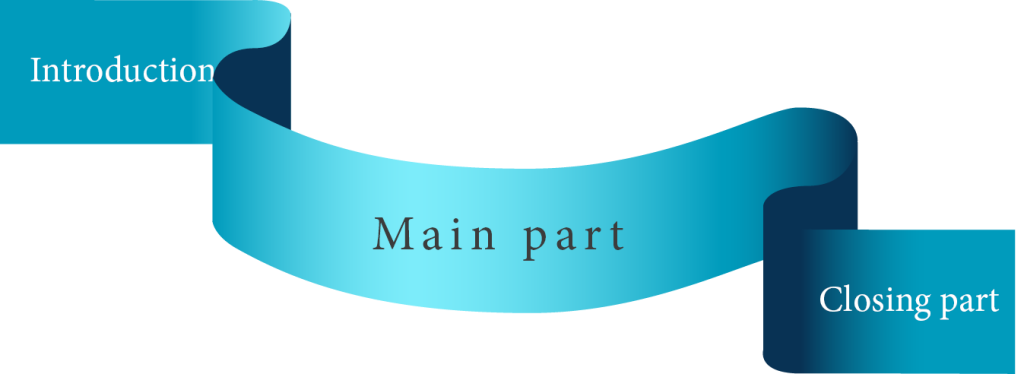The 3 parts of a presentation: introduction, main part, closing part
The task of each part for the presentation structure
A successful business presentation requires careful planning and structuring. In this article, we will look at presentation structure, focusing on the three parts: Introduction, main body, and conclusion of a presentation. We will explore what each part does and specific tips to help structure these parts of the presentation in the best possible way.

The Agenda
A successful presentation needs a well-structured agenda. It helps your audience to keep track and follow the content of the presentation. The agenda ensures that all important aspects of a topic are covered in the presentation.
An attractively designed and worded agenda can also help to capture the audience’s attention right from the start and get them excited about the presentation. For example, the agenda can be designed using images, language, or terminology that is specific to the audience’s goals and interests. In this way, the presenter signals that they value the audience’s time and interest and are tailoring their presentation to meet their needs.
Read more about the importance of the agenda in presentations and learn how to use action titles profitably as well.

Part 1: the introduction of a presentation
1. Greeting:
With a friendly greeting, you create a positive atmosphere right from the start. You give the audience the opportunity to arrive, get quiet and collect themselves and signal that it’s about to start. This phase is important to establish the audience’s concentration.
2. Introduction:
Briefly introduce yourself and your organization. Give an overview of who you are and what your role is in your organization. By doing this, you will give your audience direction and reinforce your expertise and credibility at the very beginning of the presentation.
3. Objective:
Briefly outline the topic of your presentation and explain what you hope to accomplish with the presentation. Make sure the goal of the presentation is clear and concise.
4. Context:
Explain the context in which the presentation will take place. Why is the topic important? Why is it relevant to the audience? Here you should also make sure that you connect with the audience and tailor your presentation to their needs and interests.

After the introduction, you should have achieved the following with your audience:
- The audience is focused
- They know who you are and that you bring expertise to the topic
- It knows what the presentation is about and why it is worth paying attention.

Part 2: the main part of a presentation
The main part is the most important part of your presentation from a content point of view. Here you present your information, argue for your position, try to convince the target audience or bring them to a decision. In short, the middle section is the heart of your presentation. It should be structured in a logical and comprehensible way and should be consistently oriented towards your presentation objective. The biggest challenge is to make the main part compact and not to ramble too much, but still not to make any jumps in content where you might lose your audience. Ideally, when building the main body, you follow the thought processes your audience might have and answer any questions that might pop into your target audience’s head. Of course, this requires a good knowledge of your target audience and also some experience. If you have given similar presentations before, you should take into account insights you can derive from audience reactions or questions, for example, when building your next presentation.
The main part should make up about 75% to 80% of the total duration of the presentation. These are our tips for the main body:
1. Precise headings:
Make sure the main body is clear and logical and use precise headings. They will ensure that your audience can follow your arguments. Headings that are to the point also help the speaker, for example, when you want to jump back and forth within the presentation.
2. Key messages:
Present your core messages and arguments in a logical order. Make sure to support your arguments with examples and facts to strengthen your position. Report from the field to show that you understand the needs of your target audience.
3. Visualization:
Make sure you make your information easy to grasp quickly. Whenever possible, you should make use of visualizations. Diagrams, icons, and images are quicker to grasp than columns of scrubs, and you’ll stick in their minds. Your audience is more likely to remember a good picture than the text on your slides.
After the main part, you should have achieved the following with your audience:
- The audience has understood your information and your arguments
- You have answered or anticipated your audience’s most important questions and objections
- The audience has recognized the relevance of the topic for their own needs and requirements
- The audience is ready to take the next step toward your goal.

Part 3: The conclusion of a presentation
The closing section is the last part of your presentation and gives you the opportunity to emphasize your message once again. It’s not just about leaving a strong impression. The conclusion of your presentation determines whether you have achieved your presentation goal. Were you able to find supporters for your topic? Were you able to bring about a decision? Were you able to win a new customer? In order to be able to measure the achievement of your objectives, it is important to be specific at the end of your presentation. Depending on the goal, you can give an outlook here, agree on next steps or deadlines, or already distribute tasks. Use all possibilities for a binding exit and a concrete connection. Make sure that your topic is thought about further, a project is pursued or a collaboration is started. Otherwise, unfortunately, your presentation will be forgotten very quickly or other topics will push in front of it.
The conclusion of your presentation should be about 10% to 15% of the total duration of the presentation and include the following elements:
1. Summary
Summarize the most important points of your presentation again in a short and concise way. This will remind the audience of the key messages and strengthen your overall impression.
2. Call-to-action
Conclude your presentation with a call-to-action that fits your presentation objective. Ask the audience to make a decision, buy a product, or schedule a follow-up appointment with you. This will create commitment and ensure that your presentation objective is achieved.
3. Outlook
Give an outlook on future developments or projects. Show the next steps or point out follow-up topics. By doing so, you show that you know the processes and are also an expert for the next steps and implementation.
4. Thank you
Conclude your presentation by thanking the audience. Show your appreciation for the interest and time the audience invested in your presentation. You can also include your contact information and offer to answer questions or provide further information. The thank you note should come from you in person; you don’t need a slide for that. Also read our tips for PowerPoint closing slides.

After the main part, you should have achieved the following with your audience:
- The audience follows your recommendation.
- It acts in the sense of your presentation goal.
- Your presentation is remembered and you are set with the audience as an expert on the presentation topic.
You can find many more very helpful tips on presentation structure in our blog articles on the golden thread of your presentation and presentation structure.